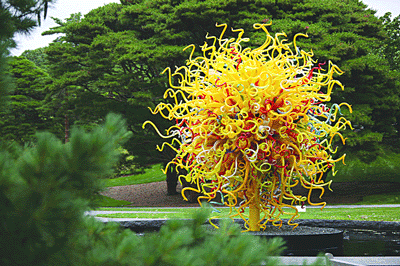The blown glass art of Dale Chihuly on view in The Bronx
My first experience seeing a Dale Chihuly sculpture was jarring. After visiting the New Orleans Museum of Contemporary Art in 1996, I came upon a foyer with a giant hand-blown glass chandelier consisting of dozens of individual, Medusa-like forms in subtly shifting blues, silvers, and whites. It was utterly surreal and the rest of the exhibit, “Chihuly Over Venice,” with its monumental scope including an entire ceiling of clear glass dotted with colored bulbs and swirls, forever changed my opinion of blown glass as an art form.
A native of Tacoma, Washington, Chihuly studied interior design, sculpture, and ceramics before winning both a Louis Comfort Tiffany Foundation Award and a Fullbright Fellowship to study at the famed Venini Fabrica on Murano Island, Italy. In 1986, Chihuly became only the fourth American artist in history to receive a solo exhibition at the Louvre.
While the Marlborough Gallery has shown small works and lesser installations for more than a decade, Chihuly has never received a substantial New York show. Finally, thanks to smart curators and planters at the New York Botanical Garden in the Bronx you can thrill to Chihuly’s work in “Gardens and Glass.”
I envy those whose first encounter may be “The Sun,” a swirl of curls, plumes, and points that rises out of a reflecting pool at the end of a long walkway. It’s a perfect five thousand-pound greeting that halts you in your tracks.
Walking slowly around “The Sun” reveals the variations in color, density, line, texture, and volume that characterize Chihuly’s style. Shapes and colors spring from every direction, while grooved or etched surfaces collide with those that are wavy and smooth. Glistening yellows, reds, and blues dominate, but look long enough and you will slowly notice the grays, greens, and browns, often stacked on top of one another or layered inside each other.
“Macchia” (from a series begun in 1981) are huge bowl-like sculptures that, with “Baskets” (begun in 1977 and located in the Conservatory), represent the oldest works here. Chihuly’s virtuoso juxtaposition of hues, undulating lines, and wave-like forms is utterly spectacular. Separated by a layer of opaque white, the inside and outside of each sculpture contain completely different combinations of pattern and color. “Macchia” was much better presented at the Atlanta Botanical Garden in 2004, where the pieces were skillfully arranged to look like blooms atop giant plants. Here, their ugly black stands stick out, creating a look more gift shop than garden.
In the Children’s Adventure Garden, Chihuly has arranged a great game of hide-and-seek. His slender, curly-tipped “Ferns” nest among the roots of a sprawling, gnarled elm and scamper up the hill.
Several dozen “Polyvitro Crystals” dot the surface of an algae-covered lily pond, a postcard perfect sight of blue sculpture against nature’s green and yellow. Polyvitro is an experimental form of plastic which, unlike glass, does not shatter when it breaks and is, therefore, safer to use for giant sculptures. Individual pieces of plastic are heated in an oven and inflated with compressed air to make asymmetrical, balloon-like balls reminiscent of oversized Christmas ornaments.
You might want to take a breather before heading into the Conservatory, where the most exciting sculptures await, including pieces from Chihuly’s two most iconic series, “Towers” and “Chandeliers,” which have long been my favorites. Outside the Conservatory stands “Rose Crystal Tower.” One of Chihuly’s techniques is the ingenious reuse of components from major sculptures to create new ones for subsequent shows. This piece, however, reconfigured from a much better piece, “Crystal Mountain,” created for Chihuly’s monumental Light of Jerusalem 2000 show, left me wanting the original.
Directly inside the Conservatory stands a far better example of reconfiguration—the show-stopping “Palm Dome Tower.” Using various elements from towers created for dozens of shows over the past decade, it will make you marvel at the snarling mass of colors—yellow, green, white, silver, sky blue, pine, azure, lemon, and lime for starters—and how the variously smooth, etched, ridged, or grooved surfaces refract light in different ways.
The gorgeous, bright yellow “Rainforest Chandelier” (2006), one of three works Chihuly created specifically for this show, suspended underneath a walkway among a dense thicket of palms, is the first of his chandeliers that viewers can examine from above. Climb up and peer down at the sculpture’s internal skeleton, in which a steel coil and vast array of wires, combined with gravity and centrifugal force hold everything together.
The Conservatory courtyards and pools feature terrific installations. Two long beds of pebbles lining the exterior walls of each Conservatory wing contain “Lavender Reeds” and seven hundred brand new tall “Red Reeds,” blown at a hot shop in Finland especially for this show. Deceptively simple at first glance, a single “Reed” from tip to base shows a complex progression of color from clear to white to blue to lavender to purple to magenta to red and back to magenta. Lovely accents come from the short, squat cactus-like “Green Grass” and swirling, dark “Floats,” little planets crashed to Earth.
The first pool features “Blue Boat,” a tangle of indigo and lavender sculptures—the latter with tips that look like the feet of tree frogs—heaped in a wooden boat, and “Blue Herons,” their legs stretching out from underneath the water, with their suave heads bowing gracefully, are grouped next to clumps of live grasses and reeds. The second pool features “Yellow Boat,” its green and yellow glass dotted with ebony Seguara. A bed in the distance tumbles with “Amber Cattails.” Each pool features a dazzling array of “Niijimi Floats” and “Walla Wallas,” whimsically shaped and named after a variety of onion—they are veritable floating glass rainbow flags.
For an added thrill, visit the Garden July 20 and 27, during which the sculptures will be lit. This will give you the particular pleasure of seeing Chihuly’s very first “Neon Tower” after dark, when it throbs with unearthly green daylight, created by 56,000 volts flowing through a half mile of neon tubing—a privet struck by lightning. Created specially for this show, it’s not only one of the best, most inventive works of Chihuly’s entire career, but also loudly proclaims he has no desire to rest on his laurels.
Let Chihuly steal your breath, arrest your summer crankiness, and melt your steely New York glare into an impish grin.
gaycitynews.com

































